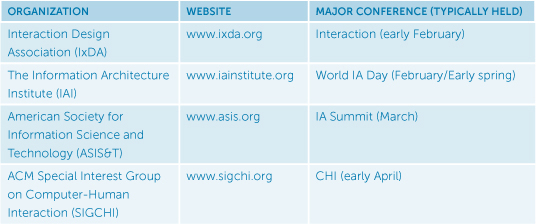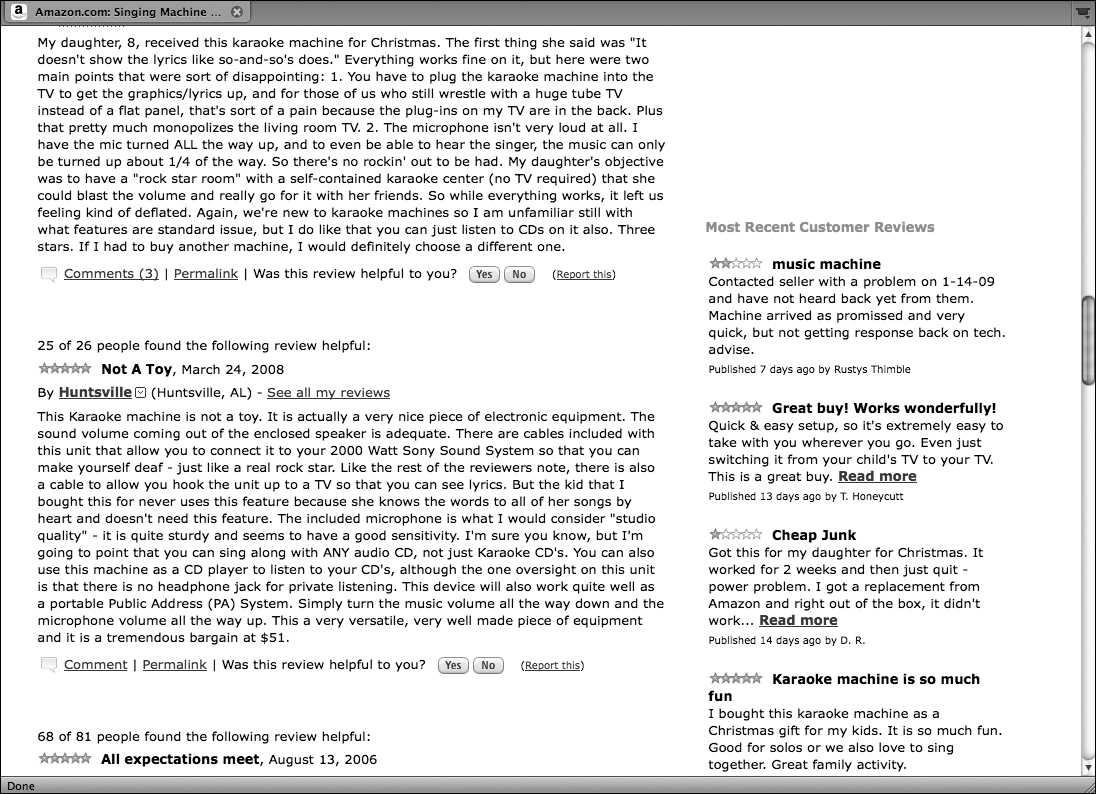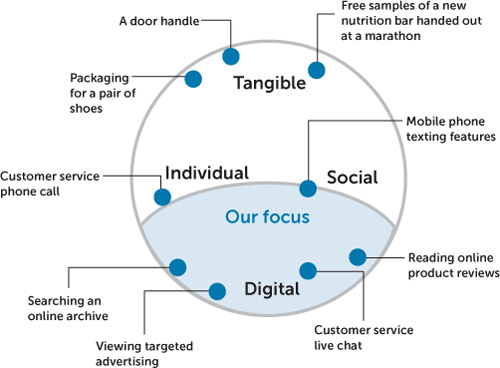1. The Tao of UXD: Curiosity Meets Passion Meets Empathy
The important thing is not to stop questioning. Curiosity has its own reason for existing. One cannot help but be in awe when he contemplates the mysteries of eternity, of life, of the marvelous structure of reality. It is enough if one tries merely to comprehend a little of this mystery every day.
Albert Einstein
A sense of curiosity is nature’s original school of education.
Smiley Blanton
Passion and purpose go hand-in-hand. When you discover your purpose, you will normally find it’s something you’re tremendously passionate about.
Steve Pavlina
The great gift of human beings is that we have the power of empathy.
Meryl Streep
Quite simply, this chapter is about you—and about others who are drawn to the field of user experience design (or UX design, for short).
If you’re reading this sentence, you’re a curious person.
You want to know how things work—anything from doorknobs to airplanes to that thing in the back of your throat. Most of all, you want to know what makes people tick.
You don’t see things as black and white; there are a whole lot of shades of gray to explore! Sure, sometimes you may drive your peers a little crazy by always volunteering to play the devil’s advocate, but it’s not like you can stop yourself from trying to look at the other side of the coin.
Lucky you!
The user experience design field attracts curious folk who are comfortable working with many shades of gray.
We seek out patterns and thrive for organization and structure. We connect the dots. We relentlessly pursue the next piece of the puzzle, and when the puzzle is solved, we look for ways to improve it!
We can be analog or digital. We are at home with pencil and paper, whiteboards and dry erase markers, Post-it notes, and Sharpie pens. We talk in terms of Axure and ‘Graffle, wireframes and prototypes, and we live in a world of boxes and arrows connected on the multiple screens of our computers.
We are not only curious. We are passionate!
We have a passion for brainstorming ideas and facilitating discussions. We have a passion for creating things that make a difference for those who use them—and those who create them. Oddly enough, we’re most proud when something we create is so good that people don’t realize how good it is!
And, of course, we have empathy.
We can feel it deep within the core of the fabric of our being when we encounter a bad experience. Even worse, we instantly try to find solutions to solve the problems.
We know what it’s like to have an unexpected response to what seems like a simple request—and we don’t like it! We don’t want users—people just like us—to have to endure the confusion and feelings of inadequacy that often go hand-in-hand with a poor experience.
When you combine that almost constant, childlike curiosity with an unrivaled passion for “doing what we do” and a sense for how others feel, you end up with a lively community of professionals who are comfortable speaking their minds, asking questions, sharing solutions, and being wrong—all in the name of getting to what is right.
Welcome to the UX design community.
What Is User Experience Design?
There are many definitions for user experience design. After all, it’s a field that thrives on defining things. Admittedly, sometimes we don’t do such a good job of “defining the damn thing” when it comes to the various parts of the whole, but we at least know what the whole is.
In this book we’ll be focusing on two definitions in particular: the broadest sense of the term UX design and the definition we will use in the context of this book.
The Broad Definition
User experience design is
The creation and synchronization of the elements that affect users’ experience with a particular company, with the intent of influencing their perceptions and behavior.
These elements include the things a user can touch (such as tangible products and packaging), hear (commercials and audio signatures), and even smell (the aroma of freshly baked bread in a sandwich shop).
It includes the things that users can interact with in ways beyond the physical, such as digital interfaces (websites and mobile phone applications), and, of course, people (customer service representatives, salespeople, and friends and family).
One of the most exciting developments of the past few years has been the ability to merge the elements affecting these different senses into a richer, integrated experience. Smell-o-vision is still far in the future, but otherwise products continue to blur the traditional lines.
Don’t Forget the Tangible
Although we’re focusing on the digital aspects of the user experience, these types of interactions don’t occur in a vacuum. Be sure to consider the effects of the tangible experience when designing your digital products. The environment your users are working within matters, as do the physical products (screens, keyboards, and other input devices) that affect the way your users will interact with your design. Chapter 6 offers techniques to help you understand the impact of context.
Also, don’t forget the other touchpoints a product or company has with those who interact with it. After all, the brand of the company is affected by many things, and the brand experience doesn’t end at the screen of a computer or a mobile phone. The best possible website design can’t make up for a reputation for poor customer service or provide the satisfaction of well-designed packaging when a product gets delivered.
Tangible experiences, such as learning in a classroom (Figure 1.1), are increasingly being influenced by digital applications.
Figure 1.1 A modern classroom experience blends the analog and the digital.
Likewise, experiences that used to be individual, such as choosing which at-home karaoke machine to buy, are increasingly becoming enhanced through social interaction, such as online reviews (Figure 1.2).
Figure 1.2 Online reviews are a major influencer of consumers.
Our Focus
As you can see, the scope of UX design is large, and growing. For the purposes of this book, we’ll be focusing on projects centered on the design of digital experiences—in particular, such interactive media as websites and software applications (Figure 1.3). To be successful, the user experience design of these products must take into account the business objectives of the project, the needs of the product’s users, and any limitations that will affect the viability of product features (such as technical limitations or constraints around project budget or time frame).
Figure 1.3 This book focuses on the digital aspects of user experience design.
About UX Designers
Although curiosity, passion, and empathy are traits that user experience designers share, there is also a desire to achieve balance. We seek out a balance, most notably between logic and emotion, like Spock and Kirk, or Data and Data in that episode where his emotion chip overloaded his positronic relays.
You get the idea.
To create truly memorable and satisfying experiences, a UX designer needs to understand how to create a logical and viable structure for the experience and needs to understand the elements that are important to creating an emotional connection with the product’s users.
The exact balance may shift according to the product. An ad campaign for a child’s toy will have a different balance than an application for tracking patient information at a hospital. A product designed without understanding the need for both is likely to miss opportunities for a truly memorable experience—and the resulting benefits to the company behind the product.
Note
For additional information about emotional design, read about design principles in Chapter 10 and check out Donald Norman’s Emotional Design: Why We Love (or Hate) Everyday Things (Basic Books, 2005).
Achieving that balance requires a heightened sense of empathy: the ability to immerse yourself in the worlds of potential product users to understand their needs and motivations. User experience designers perform research to reach this understanding (see Chapter 6) and create such tools as personas (see Chapter 7) to help the rest of the project team focus their efforts.
Remember, emotion is just a part of the overall picture. Use the logical side to bring you back from the edge and keep your mind on the tasks at hand. In most cases, you will be working against a budget that is based on the time and materials required to complete the project. You’ll need to understand that sometimes you need to fish or cut bait.
Where UX Designers Live
You’re not alone in this. Look around and you’ll find a number of organizations and communities that can foster your development as a user experience designer. In addition to offering mailing lists, online resources, and a whole slew of really smart people, many of these organizations sponsor events or conferences that can help you broaden your horizons and narrow your career focus all at the same time.
A number of companies host events geared to providing continuing education, including User Interface Engineering’s Web User Interface Conference, Adaptive Path’s UX Intensive and UX Week, and the Nielsen Norman Group’s Usability Week. In addition to these organizations, there are other conferences that you can attend, often at a very reasonable rate, such as Midwest UX (http://midwestux.com), Big Design (http://bigdesignevents.com), and WebVisions (http:/webvisionsevent.com/) and plenty of meetup groups (http://meetup.com) that will allow you to meet with like-minded individuals, see talented speakers, and learn from people in your area.
There has also been a growth in the number of longer UX courses, like Robert Hoekman Jr.’s online course (https://learnable.com/courses/user-experience-tools-tricks-techniques-183) and in-person courses like those offered at Code Academy.
Several professional organizations sponsor yearly conferences, as well. Table 1.1 provides a short list of some of the more well-known organizations, their websites, and events that they host.
Table 1.1 A Sampling of UX Organizations

Let’s Get Started!
You’ve made it this far. It’s time to get into the reason you picked up this book in the first place. Turn the page and take a dive into how user experience design exists within the realm of projects.
But don’t stop there—this book is a guide to get you started. It has a lot of examples that can help you deliver on many of the activities you will be tasked with. We’ve also tried to provide additional examples to help you expand and find your own best approach for creating deliverables that are useful to your team and your clients.
Keep your curiosity, passion, and empathy alive! Challenge yourself to find new ways to inspire others to build that ideal user experience.
That is, of course, before you set out to improve upon it.



